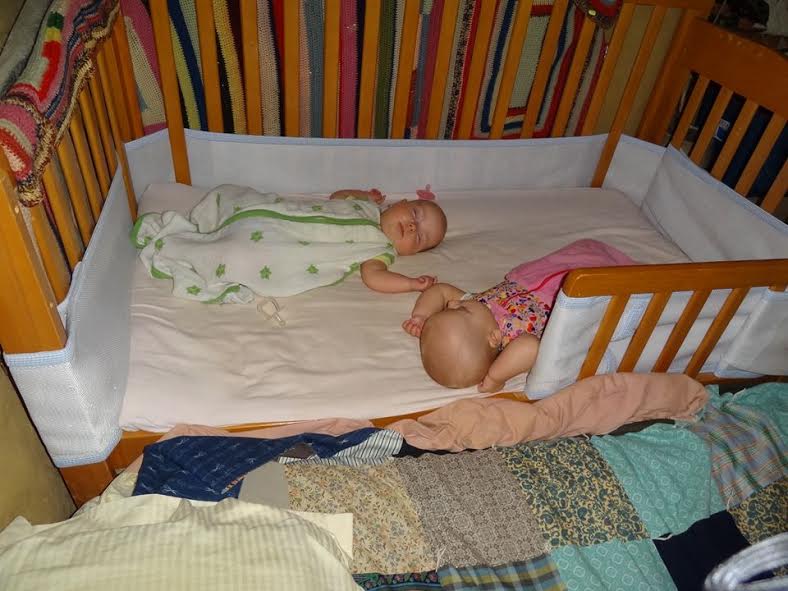by Davina Wright
Many parents choose to co-sleep with their babies and young children. It can be a wonderful way to be close to each other and to meet their needs, while maximising your own sleep. If you think that co-sleeping is right for your family, there are things you can do to make it just as safe as any other sleep dynamic.
Firstly, ‘co-sleeping’ is actually a general term that includes sleeping in the same room as your baby, and ‘co-bedding’, or ‘bed sharing’ are the specific terms for sleeping in the same bed. – so, many parents may be co-sleeping without even realising it. Co-sleeping comes in many varieties: you can have a big bed that Mum, Dad and baby all sleep in together; you can have a big bed that Mum and Dad sleep in, while baby sleeps in a bassinet/cot right next to the bed; you can have a cot ‘side-carred’ to (i.e., pushed against) your big bed; or you can have a big mattress on the floor with a cot mattress pushed up against it. My own co-sleeping arrangements with triplets changed often as we tried to find what worked best for us as the babies grew. At first we had Daddy sleeping on a big bed in the nursery with two of the babies in their own cots, while I slept in our bed with one baby in a Moses basket on the bed. Then, as that baby fed more frequently, he was often just right there in bed with me. As he got older we side-carred his cot up against our bed, so we both had more space, but he was still right there. A triplet mum I know slept in her big bed (hubby ended up on the couch) with her three tiny babies all on blankets around her, and as each needed to be fed she would just slide them around into position, thus not waking anyone that didn’t need feeding. So you can co-sleep with just one, or two or three!
Dr. James McKenna is recognised as the leading authority on mother-infant co-sleeping. There is a great deal of his research online, and he has written an excellent book Sleeping with your baby – a parent’s guide to co-sleeping. He says, “the terms co-sleeping, bed sharing, and a well-known dangerous form of co-sleeping, couch or sofa co-sleeping, are mostly used interchangeably by medical authorities, even though these terms need to be kept separate. It is absolutely wrong to say, for example, that ‘co-sleeping is dangerous’ when room sharing is a form of co-sleeping, and this form of co-sleeping reduces an infant’s chances of dying by one half. Bed sharing is another form of co-sleeping which can be made either safe or unsafe, but it is not intrinsically one nor the other”. Click here to read more from Dr. McKenna.
Guidelines for safe sleeping, regardless of where a baby sleeps, include:
- A healthy gestation, specifically without the foetus being exposed to maternal smoke
- Breastfeeding, which significantly helps to protect babies from SIDS/SUDI
- Safe postnatal baby begins especially with the presence of an informed, breastfeeding, committed mother, or an informed and committed father
- Babies should sleep on their backs, on firm, clean surfaces, in the absence of smoke, and under light (comfortable) blanketing, and their heads should never be covered
- The bed should not have any stuffed animals or pillows around the baby, and a baby should never be placed to sleep on top of a pillow
- Sheepskins or other fluffy material, and especially bean bag mattresses, should never be used
- Waterbeds can be dangerous and mattresses should tightly intersect the bed-frame at all times
- Babies should never sleep on couches or sofas, with or without adults, as they can slip down (face first) into the crevice or get wedged against the back of a couch
Further guidelines to promote safe bed sharing include:
- Bottle-fed babies should always sleep alongside the mother on a separate surface, rather than in the bed
- If bed-sharing, both parents should agree and feel comfortable with the decision. Each bed-sharer should agree that he or she is equally responsible for the baby and acknowledge that the baby is present
- Babies under one should not sleep with other children, such as siblings, and should always sleep always with a person who can take responsibility for the baby being there
- People on sedatives, medications or drugs, intoxicated people, or people who are excessively difficult to rouse from sleep should not co-sleep on the same surface with the baby
- If the mother has excessively long hair she should tie it up to prevent entanglement around the baby’s neck
- Extremely obese people, who may not feel where exactly or how close their baby is, may wish to have the baby sleep alongside but on a different surface
(These guidelines are based on those found at http://cosleeping.nd.edu/safe-co-sleeping-guidelines/)
If you think that co-sleeping or bed sharing could work for your family, to best thing that you can do is arm yourself with the knowledge of how to do it safely and properly. Two further resources are Dr. Bob Sears and Dr. Jay Gordon.
Connor, Willow, and Summer Wright: very comfortable together!
**Davina Wright has written about her breastfeeding journey for various publications including NZ La Leche League magazine, NZ Multiple Birth Association magazine, NZ North Shore Multiple Birth Club newsletter, NZ Triplets Plus club newsletter, Hong Kong La Leche League newsletter and La Leche League International magazine. She also does guest blog posts and has put together a triplet breastfeeding advice column and video with other triplet mamas. She is in training to become a La Leche League leader to continue offering support to other breastfeeding mothers. She works daily to support Moms on-line as an Admin at The Badass Breastfeeder and has written other guest blog posts Attachment Parenting with Triplets and Coming Out of the Blur. She still only has two breasts.













